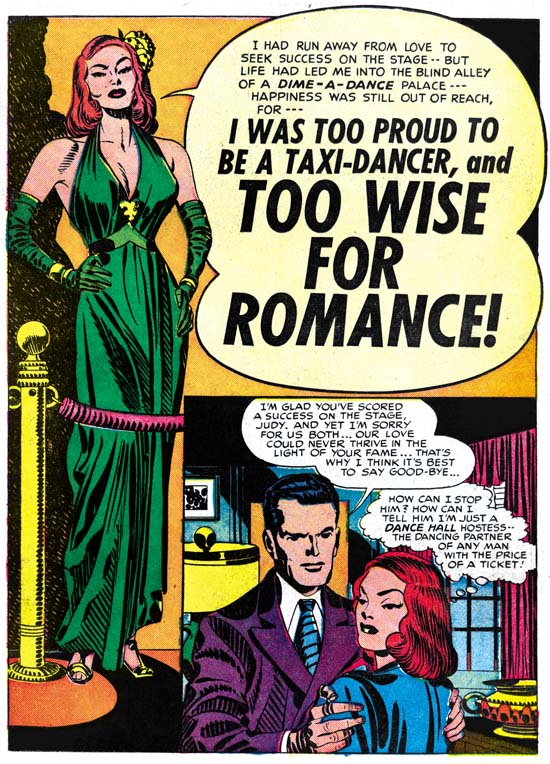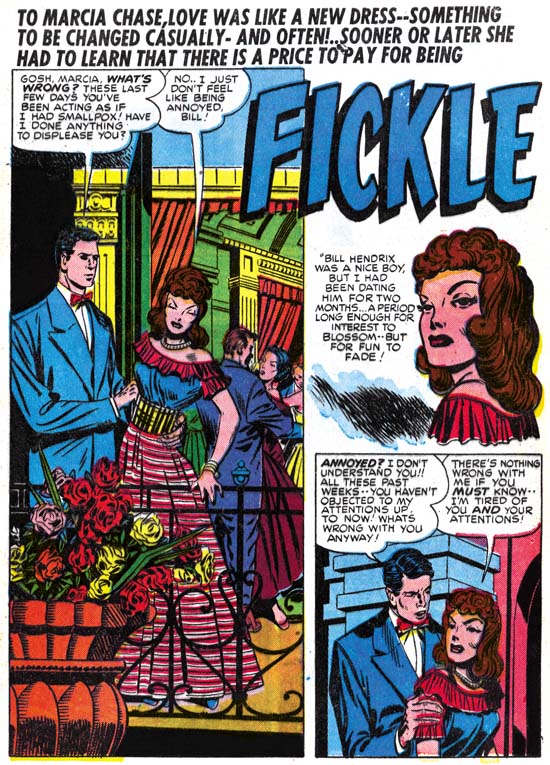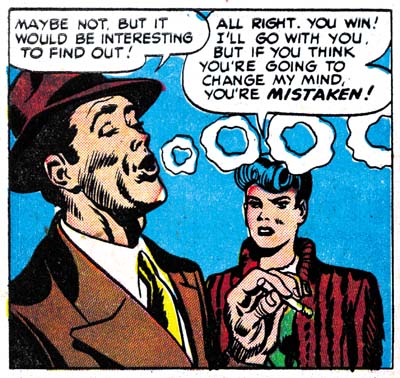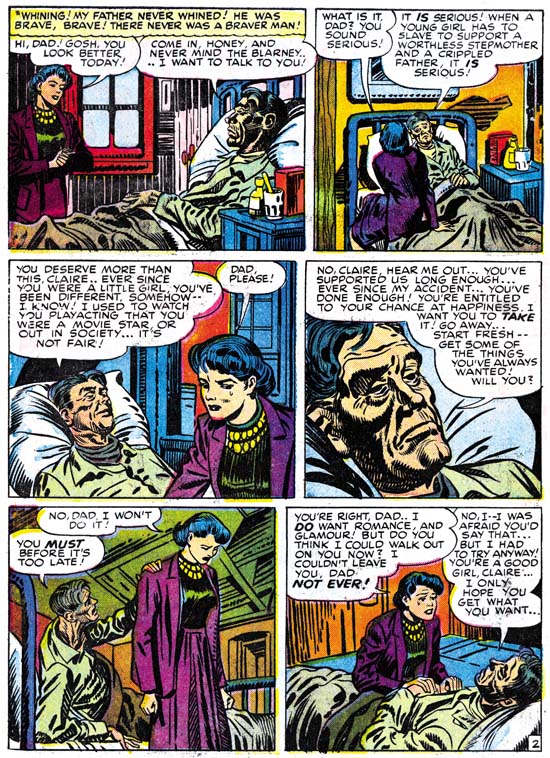(Young Romance #9 – #12, Young Love #1 – #4)
As I discussed in my previous chapter, other publishers did not fail to notice Prize’s success with Young Romance. Three competing romance titles had appeared with cover dates of September and October 1948. It is understandable that competitor publishers may not have fully understood what a gold mine Simon and Kirby had opened. Print runs of Young Romance were increased and with their deal S&K were getting a share of the profits. What was puzzling was the lack of response by Prize as well as Simon and Kirby for their own success as Young Romance continued to be a bimonthly. In February 1949, after about a year and a half of Young Romance, Simon and Kirby finally produced a new romance title, Young Love, which Prize also published. Both Young Romance and Young Love were initially bimonthlies but were released on an alternating schedule so a S&K romance would be available each month. The two titles shared similar contents without any distinguishing themes. Effectively S&K and Prize could have just as easily have made Young Romance a monthly. However having two bimonthly titles left open the possibility of future expansion by converting to monthly later. That was not the end of their plans, Simon and Kirby would also produce two new titles that combined the romance and western genre; Real West Romance (April 1949) and Western Love (July 1949). These later titles were true romances, but the western aspect gives them a distinguishing characteristic. Therefore I prefer to deal with the western romance titles sometime in the future in a separate chapter. In this and the following chapter I will write about the standard romance comics from Young Romance #9 (January 1949) until Young Love #4 (August 1949). The actual issues are Young Romance #9 to #12 and Young Love #1 to #4.
This period starts with just 4 publishers of romance and the same number of titles. By the end, that is cover date August 1949, there would be 12 publishers and 37 titles. Fox, one of the initial publishers after Prize, must have had a good response since by the end of this period they had 10 romance titles. Timely, another of the initial publishers had by August 6 love titles. Impressive as this is it was just the beginning of the rush to tap into the lucrative market opened by the romance genre. (Title information garnered from “All the Romance Comics Ever Published (?)” by Dan Stevenson.)
The artists that make the overwhelmingly greatest contribution to the Young Romance and Young Love in this period are the same ones from previous issues; Jack Kirby and Bill Draut. The real significant change is the proportion each of these two artists shared. Unlike before where Jack did the largest portion of the work, in this period Bill takes the lead. In the eight issues discussed here Kirby did 10 out of 44 stories and 112 pages out of 342. This compared to the 18 stories and 136 pages that Draut drew. The amount of art that Jack was producing for the crime genre titles had dropped during this period as well. The explanation was not for the artistic work that Kirby would provide to the new titles Real West Romance and Western Love as his contribution to those titles was relatively small. Adding these western romances to their other titles meant that Simon and Kirby were producing a lot of work. Joe Simon and others have said that Jack took an active part in the plotting of work done by all the studio artists. Perhaps plotting and other support activities were keeping Jack away from the drawing board more then before.

Young Love #4 (August 1949) photo cover of Joy Lansing
Not that Kirby lost his dominance in all artistic aspects during this period. Jack continued to be the chief supplier of the first story. This featured story generally was the longest with typically 10 to 14 pages compared to most of the other stories which often were 6 to 9 pages if not shorter. Occasionally art was included in the text stories that were required for lower postal rates. This was done 4 times with Jack supplying the art for 3 of those occasions. Most importantly Kirby continued to be the cover artist. All cover art was done by Jack but with one occasion there was a small insert added to the Kirby cover was lifted from a splash page penciled by Bill Draut. The big change came with Young Love #2 which saw the first use of a photograph as the cover for a Prize romance title. Nothing is provided that identifies the model for the cover but it does look like a head shot of some actress. The next two issues used photos of Joy Lansing described in one comic as a “Hal Roach Television Starlet” and in the other as a “MGM Starlet”. This is the beginning of a run of photographic covers for Young Love, but Young Romance would not follow suit until after the period under discussion.

Young Romance #11 (May 1949) “The Town and Toni Benson”, art by Jack Kirby
While all the stories are good reads it is Kirby’s feature stories that seemed the most dramatic and explored the more interesting themes. In a rare example of continuity in romance comics “The Town and Toni Benson” returns to the same couple who were the subjects of “I Was a Pick-Up” the featured story from Young Romance #1. The majority of romance stories are about the start of a romance. Those that cover later periods in the relationship usually have a love lost and regained theme. In “The Town and Toni Benson” Jack explores the drama of a woman who married for love and not for money. In this story we see the couple’s struggle as they start their new life. Most of Simon and Kirby’s teenage readers would be more interested in the other themes I mentioned but I sure wish stories like this one would had been done more often.
In the issues that I cover in this post I continue to find some of Kirby’s best stand alone art work not on the covers but in the splash pages of the featured stories. The one for “The Town and Toni Benson” is a particular favorite. This may seem surprising because this is one of Simon and Kirby’s simplest splashes. There is no action and it lacks the melodrama found in many other romance art by Simon and Kirby, but it crystallizes the story’s theme. Toni stands erect, shoulders square, legs apart, as if braced to take on whatever the world may throw at her. Although her husband’s hands seem to offer support, it is Toni who projects the most courageous defiance. The breeze that ruffles Toni’s hair and shifts her dress is the only true action found in this splash. The town that embodies the difficulties that they will face together lies literally at their feet. The Studio Style inking, bold yet sensitive, provides just the right touch.

Young Romance #10 (March 1949) “Mama’s Boy” page 11, art by Jack Kirby
As I mentioned in a previous chapter Jack had a number of techniques to add interest to his romance work to compensate for the missing action that is such an essential aspect of the other comic genre. Methods like varying the “camera” angle or placing foreground objects in front of the primary characters. These various techniques show up in Kirby’s crime work as well but seem to play a more important part for the romance stories. Action, in its varied forms, is still inserted into romance stories by Jack as attested by the above image from “Mama’s Boy”. However note how the greatest action, the crash scene, is found in the second panel. The action is not the subject of this page but just the introduction. Here the drama resides in the injury that one an occupant of the car sustains. Although we see the slumped form of the hurt man it is from the fearful countenance of his disheveled friend in the last panel that we truly learn the seriousness state of the accident victim. This is another example of Kirby showing what a master he was even outside of the type of story telling that he is normally famous for. Further it is not just this page, the next one depicting the man performing an emergency operation out in the field with primitive tools. Again the drama is in the actors and we do not see the gory details of what is actually being done. This is years before the Comic Code, it is only Simon and Kirby’s own good taste that censors what we see. In my opinion, the story is all the better for the way it is handled.

Young Love #2 (April 1949) “Too Wise for Romance”, art by Jack Kirby
Some have criticized Kirby’s females as not being very beautiful. While it is true that the harden yet sultry woman in “Too Wise for Romance” is no Barbie doll, surely she is beautiful in her own way? With hands on her hips and a plunging neckline she certainly projects an alluring image. It is obvious that Kirby has not studied classical sculpture but he still understands the importance of properly indicating the form of the flexed leg under the flowing dress. This is not as easy as Kirby makes it look as many others who have studied ancient Greek art have failed to pull it off so well. Once again Jack has created a very specific personality and not a generic beauty, but this is a romance story so do not be surprised that the sexy but formidable exterior hides a warm heart.
Like almost all feature story splashes this one uses a word balloon to provide the introduction and title. The single panel found in the corner has the appearance of a story panel but actually it is part of the splash. The true start of the story on the next page has a very different beginning.
The inking of this splash is as good an example of the Studio Style that could possibly be found. Picket fence crosshatching, drop strings, abstract arches and shoulder blots all play prominent parts on this page (see my Inking Glossary for an explanation of these terms). It is another one of those splashes that I find so much more effective then Jack’s own romance covers. This is a general observation that suggests that Joe and Jack purposely kept the more provocative art inside the cover where it would not attract as much unwanted attention from those who were foes, not fans, of comic books.

Young Love #1 (February 1949) “Fickle”, pencils by Jack Kirby
As in previous chapters of this serial post, I have found some stories that do not so perfectly match other contributions by Jack Kirby. “Fickle” is included in the Jack Kirby Checklist so here deviation from more typical Kirby work is not too great. But note the narrow clothing folds that dominate on the splash page shown above. Although we have seen narrow folds in some of the images I provided above (all of which I believe were inked by Kirby himself) they are used when the image calls for them. Otherwise clothing folds are generally indicated by picket fence crosshatching or simple spatulate and frond shapes. Elsewhere in “Fickle” can be found all the inking mannerisms typical of the Studio Style but still the long narrow clothing folds persist. Jack did not ink this page but the artist who did was very comfortable with the Studio Style. The inker may also have altered the man on this page, note how the head seems too small for his body.

Young Romance #9 (January 1949) “The Easy Life” page 6 panel 1, art by Jack Kirby and Joe Simon
While “Fickle” was recognized as a Kirby work by the Jack Kirby Checklist, “The Easy Life” was not. It is not hard to understand why as most of the art in this story does not have so obvious a Kirby touch as compared to those I have discussed and illustrated above. There are some parts where there can be little doubt about Jack’s contribution. Perhaps the most convincing is the smoker in the panel from page 6 shown above. The woman sharing the panel is not so certainly a work by Jack. As I commented in a previous chapter there are a number of explanations for this state of affairs. I think we can discount an artist simply swiping from Kirby; the smoker is much too good to be just that. That still leaves other possible explanations; an artist working from Kirby layouts, the effects of an inker on Kirby pencils, or Jack in his roll as art editor fixing up another artist’s work. The way to choose between these options rests in the examination of the entire store, not just individual panels.

Young Romance #9 (January 1949) “The Easy Life” page 2, art by Jack Kirby and Joe Simon
Unfortunately it is inappropriate, perhaps even illegal, in a blog like this to provide images for the entire story. All I can say is that I believe the layouts used throughout are in good agreement with the page I present above. The graphic story telling methods found seem consistently like those used by Kirby. Therefore I believe we can exclude the Kirby as art editor explanation. The story is so uniform throughout that it does not appear to be an “in betweener” work (where Kirby would lay out a story for another artist starting with tight pencils, providing little more then roughs through most of the story and then tightening up again at the end). It comes down to a judgment call, one that others might disagree, but I find the art looks enough like Kirby’s that I accept this as his pencils inked by another artist. The inking is interesting because it is done quite well in the Studio Style. Trademarks of that style such as picket fence crosshatching, drop strings, abstract arch shadows and shoulder blots are used. Of all the art in the story it is the main character Claire that looks the least like Kirby’s work. I find the drawing of Claire in panel 3 of the above page to particularly resemble work done by Joe Simon. I believe Joe has “corrected” Kirby’s main character in order to make her more beautiful. Simon did the same thing in the DC reprints of Black Magic from the ’70s. This is another of those cases where a simple designation of the penciler and inker really does not adequately describe what was going on. (Lately I keep encountering issues related to Joe Simon’s inking so I clearly have to address that subject soon.)
Jack Kirby was not the only artist in these particular romance comics nor is he the only subject of interest for this blog. Besides Bill Draut’s greater presence there are a few other artists that make their first appearance in a Simon and Kirby comic. They will be the subject of next week’s Chapter 5 of The Art of Romance.
Chapter 1, A New Genre (YR #1 – #4)
Chapter 2, Early Artists (YR #1 – #4)
Chapter 3, The Field No Longer Their’s Alone (YR #5 – #8)
Chapter 4, An Explosion of Romance (YR #9 – #12, YL #1 – #4)
Chapter 5, New Talent (YR #9 – 12, YL #1 – #4)
Chapter 6, Love on the Range (RWR #1 – #7, WL #1 – #6)
Chapter 7, More Love on the Range (RWR #1 – #7, WL #1 – #6)
Chapter 8, Kirby on the Range? (RWR #1 – #7, WL #1 – #6)
Chapter 9, More Romance (YR #13 – #16, YL #5 – #6)
Chapter 10, The Peak of the Love Glut (YR #17 – #20, YL #7 – #8)
Chapter 11, After the Glut (YR #21 – #23, YL #9 – #10)
Chapter 12, A Smaller Studio (YR #24 – #26, YL #12 – #14)
Chapter 13, Romance Bottoms Out (YR #27 – #29, YL #15 – #17)
Chapter 14, The Third Suspect (YR #30 – #32, YL #18 – #20)
Chapter 15, The Action of Romance (YR #33 – #35, YL #21 – #23)
Chapter 16, Someone Old and Someone New (YR #36 – #38, YL #24 – #26)
Chapter 17, The Assistant (YR #39 – #41, YL #27 – #29)
Chapter 18, Meskin Takes Over (YR #42 – #44, YL #30 – #32)
Chapter 19, More Artists (YR #45 – #47, YL #33 – #35)
Chapter 20, Romance Still Matters (YR #48 – #50, YL #36 – #38, YB #1)
Chapter 21, Roussos Messes Up (YR #51 – #53, YL #39 – #41, YB #2 – 3)
Chapter 22, He’s the Man (YR #54 – #56, YL #42 – #44, YB #4)
Chapter 23, New Ways of Doing Things (YR #57 – #59, YL #45 – #47, YB #5 – #6)
Chapter 24, A New Artist (YR #60 – #62, YL #48 – #50, YB #7 – #8)
Chapter 25, More New Faces (YR #63 – #65, YLe #51 – #53, YB #9 – #11)
Chapter 26, Goodbye Jack (YR #66 – #68, YL #54 – #56, YB #12 – #14)
Chapter 27, The Return of Mort (YR #69 – #71, YL #57 – #59, YB #15 – #17)
Chapter 28, A Glut of Artists (YR #72 – #74, YL #60 – #62, YB #18 & #19, IL #1 & #2)
Chapter 29, Trouble Begins (YR #75 – #77, YL #63 – #65, YB #20 – #22, IL #3 – #5)
Chapter 30, Transition (YR #78 – #80, YL #66 – #68, YBs #23 – #25, IL #6, ILY #7)
Chapter 30, Appendix (YB #23)
Chapter 31, Kirby, Kirby and More Kirby (YR #81 – #82, YL #69 – #70, YB #26 – #27)
Chapter 32, The Kirby Beat Goes On (YR #83 – #84, YL #71 – #72, YB #28 – #29)
Chapter 33, End of an Era (YR #85 – #87, YL #73, YB #30, AFL #1)
Chapter 34, A New Prize Title (YR #88 – #91, AFL #2 – #5, PL #1 – #2)
Chapter 35, Settling In ( YR #92 – #94, AFL #6 – #8, PL #3 – #5)
Appendix, J.O. Is Joe Orlando
Chapter 36, More Kirby (YR #95 – #97, AFL #9 – #11, PL #6 – #8)
Chapter 37, Some Surprises (YR #98 – #100, AFL #12 – #14, PL #9 – #11)
Chapter 38, All Things Must End (YR #101 – #103, AFL #15 – #17, PL #12 – #14)

